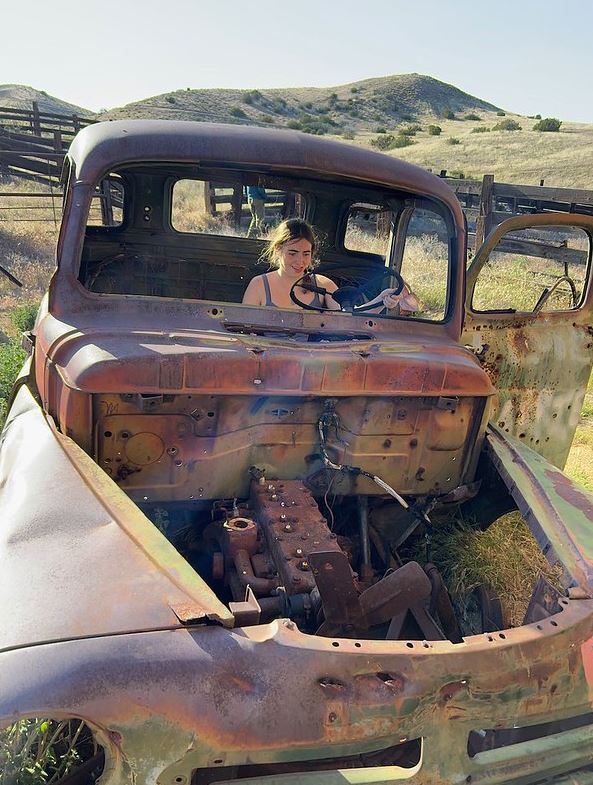
The Eta Aquarid Meteor Shower, which peaks May 4 and should produce meteors all weekend. Usually it produces about 15-20 meteors per hour, but once in a while produces a sharp maximum which. There's also the last views of the northern Milky Way still visible in Gemini, Orion, Perseus, and Cassiopiea, with star formation regions, star clusters, nebulae, and wonderful photo opportunities. The waning crescent moon won't rise till 3:30am on Saturday, and even later on Sunday, Alas, the Eta Aquariid meteors come from Aquarius and don't rise until just before dawn. I won't require people to get up to observe them, but if you are an early riser, maybe join me?
 |
Carrizo Plain is a beautiful place, especially in the Spring, when wildflowers can be spectacular. It is also the generally acknowledged most impressive place to see the land forms created by Earth quakes along the San Andreas Fault, which we'll explore during the day. Usually late April is warmer and better weather, but also the flowers are usually past their peak but still it is green and scenic. We can camp for free up in the Caliente Mountains, as we've done many times in past years for Astro 28 and Astro 25. This Spring '24 we have had good rains and the forecast is for a good flower season which should still be in force in early May.
 |
 |
PDF of PowerPoint Presentation. This has a class in a nutshell, and an early version was shown at the Pre-Trip meeting. It's been updated and it has valuable maps for you as well.
PDF of PowerPoint on Planetary Science
 |
 |
Pascal will already be there, arriving on Thursday. Look for Pascal in his white vehicle with white service dog Belle. Kirk Bender may also be there, in his dark blue Prius and his 17" big telescope to help show us the stars and galaxies.
6:40pm Dinner: fixed before sunset, we want to be cleaned up by dark.
8:00pm- ~midnight - clean up done, bring out scopes, watch and photo sunset, and micro-lectures on stellar evolution, and laser pointing of example stars
Before dawn, optional getting up to see the rising cresent moon, Mercury, and the Eta Aquariid meteors, and photo sunrise.
8am - I'll be starting breakfast prep. Hopefully we can get some help carving fruit for the crepes. Rick's famous French Crepes Breakfast!
9am - breakfast should be in full swing.
10:30am - done, cleaning up, and get your lunches and daypacks ready so we can jump in the vans and head down to...
Our destinations for Saturday: The Goodwin Visitor's center, Soda Lake, Wallace Creek, Painted Rock (?? Only if it's possible they have a tour scheduled we can join. I'll find out), drive south along Elkhorn Rd into the fault zone you see on the aerial famous photo
 |
Late afternoon. Return to camp, get some down time.
7pm - Dinner in full swing, Asia Rice a'la Nolthenius, with fresh veges, cocoanut creme, spices, jasmine rice. Only for those who opted for the meal package.
8:30pm - It's dark, time for telescopes. And astrophotography demonstrations. There's also an asteroid occultation just after 9pm which we hope to be able to record, demonstrating real science in action. If it's cloudy, we will also have a campfire and talks around the fire.
Till later, like 12 midnight- Enjoy galaxies as the Virgo Cluster rises and the Coma Cluster of Galaxies, early views of the Summer Milky Way's core.
 |
8:30am - I fix breakfast! Eggs and seasonings, vege additions, with pan fried cowboy toast in olive oil.
Pack up camp at our leisure. Drive down to Topaz Solar Farm for a micro-lecture on solar PV and climate change. Then head back north along Bitterwater Road, which follows the trace of the San Andreas Fault, with stops to show of unique landforms. Van driver Kenny and students can decide on other stops, if any, while the gear van heads on back to Santa Cruz.
 |